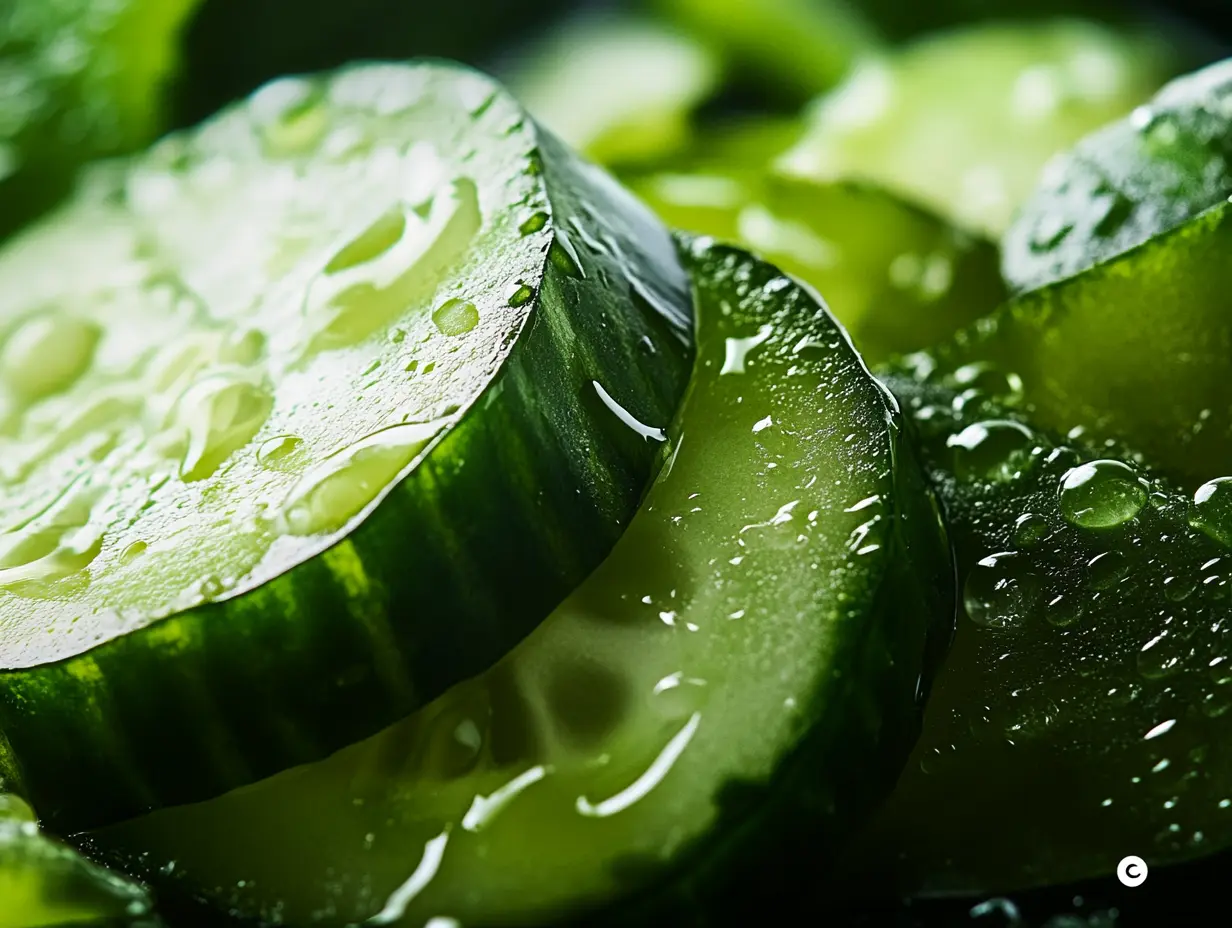Why Are Japanese Cucumbers So Good? Exploring Flavor, Texture, and Culinary Uses
Introduction
Why are Japanese cucumbers so good? This question often arises as these slender, vibrant cucumbers gain popularity worldwide. Known for their crisp texture, fewer seeds, and mild sweetness, Japanese cucumbers are setting a new benchmark in global cuisine. From gourmet kitchens to home-cooked meals, these cucumbers shine in a variety of dishes. Compared to their bulkier counterparts, they exude a certain elegance and finesse.
The goal of this article is to uncover what truly sets Japanese cucumbers apart. We’ll delve into their unique qualities, nutritional benefits, and cultural significance while exploring their versatility in culinary applications. Whether you’re a chef or a home cook, you’ll find plenty of reasons to incorporate this extraordinary vegetable into your meals. So, let’s uncover why Japanese cucumbers are truly exceptional.
What Makes Japanese Cucumbers Unique?
What elevates Japanese cucumbers above standard varieties is a trifecta of their appearance, flavor, and structural advantages. One of the most defining features of Japanese cucumbers is their slender, elongated shape. Their smooth, dark green skin lacks the prickly bumps present in many other types, making them visually appealing and easy to prepare. Transitioning from aesthetic to functional, their texture is delightfully crisp, with a satisfying snap when bitten into.
Another remarkable characteristic is the seedless or minimal seed profile. Traditional cucumbers often come with watery, mushy seed cores that may dilute the flavor or texture of a dish. Japanese cucumbers circumvent this issue entirely. Their interiors remain firm and consistent, adding value to salads, sushi rolls, and even pickles.
In terms of flavor, Japanese cucumbers are subtly sweet and mild compared to the bitterness sometimes found in regular cucumbers. This balanced taste enhances any dish they complement. Moreover, their ability to retain texture even under heat or refrigeration makes them a versatile star in both hot and cold recipes.

Nutritional Benefits of Japanese Cucumbers
Japanese cucumbers aren’t just about looks and taste; they also pack impressive health benefits. With their high water content and low calorie count, they’re the perfect guilt-free snack. A single serving contains only a few calories, making them an ideal choice for weight-conscious individuals. Unlike sugary or carb-heavy snacks, these cucumbers help curb hunger while keeping you hydrated.
Rich in essential vitamins and minerals, Japanese cucumbers contribute significantly to a well-rounded diet. They are an excellent source of Vitamin K, which supports bone health, and Vitamin C, known for boosting the immune system. Additionally, they contain potassium, which helps regulate blood pressure and maintain proper muscle function.
Not to be overlooked is their high dietary fiber content. This fiber aids digestion and promotes a healthy gut microbiome. Moreover, their water-rich composition helps prevent dehydration, especially during warmer months. Adding Japanese cucumbers to your meals is an easy and delicious way to meet your daily hydration and nutritional needs. Transitioning to a healthier lifestyle has never been so simple—or tasty.
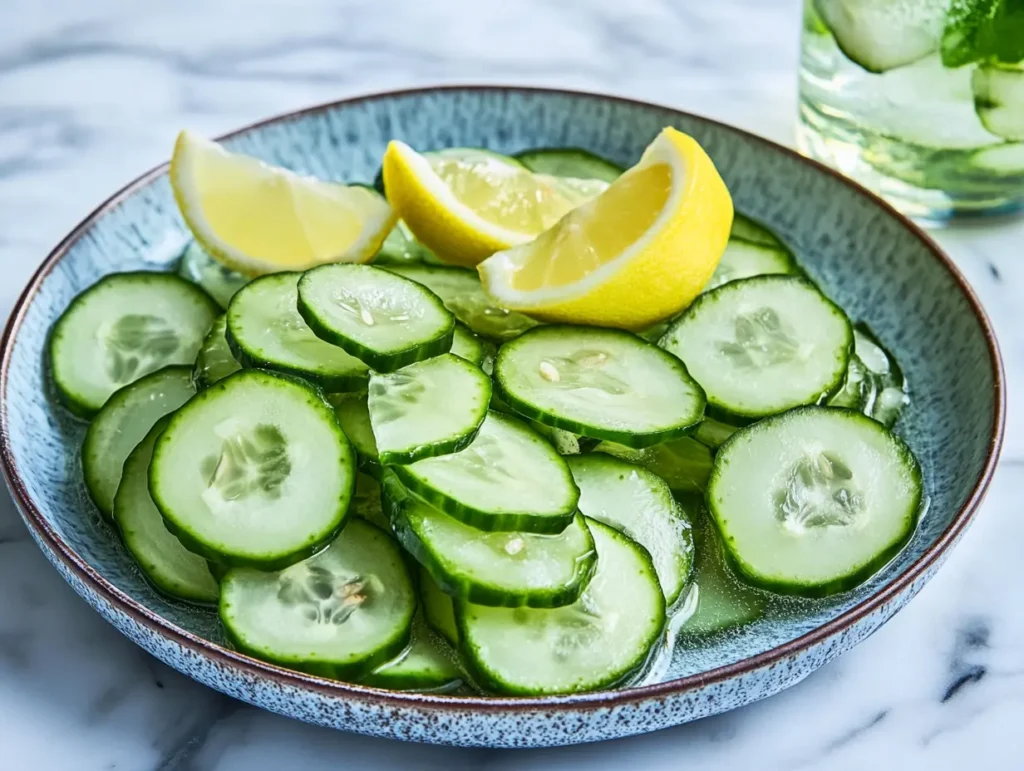
The History and Origin of Japanese Cucumbers
The history of Japanese cucumbers begins with their deep-rooted cultural significance in Japan. Cucumbers, known as “kyuri” in Japanese, have been a staple in traditional cuisine for centuries. They are frequently featured in side dishes, soups, and pickled accompaniments like “tsukemono.” Their refreshing qualities make them particularly valuable during Japan’s humid summers. Transitioning through history, these cucumbers embody the Japanese ethos of simplicity and elegance in food.
Unlike mass-produced vegetables, Japanese cucumbers are often cultivated using meticulous methods. Farmers prioritize quality over quantity, ensuring each cucumber meets exacting standards. Hand-harvesting is a common practice, which reduces bruising and maintains their pristine appearance. Their cultivation involves attentive soil preparation and natural pest control techniques, aligning with Japan’s commitment to sustainable agriculture.
Beyond their local roots, Japanese cucumbers have made a significant international impact. The global spread of Japanese cuisine, driven by sushi restaurants and health-conscious recipes, has skyrocketed their demand. Today, you can find Japanese cucumbers in specialty grocery stores and farmers’ markets worldwide. Thanks to their growing popularity, numerous chefs and culinary enthusiasts continue to adopt them globally.
Explore the secrets behind the famous Din Tai Fung cucumber recipe to elevate your cucumber dishes
Selecting the Perfect Japanese Cucumber
Choosing the right Japanese cucumber is an essential first step in enjoying its unique qualities. To get the freshest and most flavorful cucumbers, there are a few things you need to look out for. First, ensure the cucumber has a vibrant, dark green color. Avoid ones with dull or yellowish tones, as these can indicate they are overripe or past their prime. Additionally, the skin should be smooth, glossy, and free of blemishes or soft spots. A fresh Japanese cucumber also has a firm texture when gently squeezed.
Moreover, it’s important to consider the seasonality of this vegetable. Japanese cucumbers are typically at their peak during the warmer months, from late spring to early autumn. During this time, their texture and flavor are at their best, making them perfect for raw dishes such as salads and pickles. However, thanks to global cultivation and greenhouse farming, high-quality Japanese cucumbers are now available year-round in many places. This ensures that you can enjoy their unique crispness and sweetness no matter the season.
Proper storage tips are crucial to maintaining the quality of Japanese cucumbers after purchase. Always store them in the refrigerator, ideally in a crisper drawer, where they will remain fresh for up to a week. Wrap them in a damp paper towel and place them in a plastic bag to prevent them from drying out. It’s also best to use them as soon as possible to enjoy their full flavor and texture.
By following these simple guidelines, you can make sure you choose and preserve the best Japanese cucumbers for all your culinary needs.
Classic Japanese Cucumber Recipes
The unmatched flavor and texture of Japanese cucumbers make them a favorite ingredient in many traditional recipes. One of the most popular is Cucumber Sunomono, a refreshing vinegar-based salad. To prepare this dish, thinly sliced Japanese cucumbers are marinated in rice vinegar, sugar, and soy sauce to create a perfect balance of sweet and tangy flavors. This dish is incredibly easy to make and pairs well with just about any Japanese meal. Try serving it as an appetizer or a light side dish.
Another crowd-pleaser is Cucumber and Tofu Salad. This recipe features cubed Japanese cucumbers and silken tofu, tossed with a dressing made from sesame oil, soy sauce, and lemon juice. The creamy tofu complements the crunch of the cucumbers beautifully, creating a dish that’s both healthy and satisfying. Add a sprinkle of toasted sesame seeds for an extra layer of flavor and texture.
For more inspiration, you can explore authentic recipes on reliable external sites like Authentic Japanese Cucumber Recipes. Whether you’re an experienced chef or a home cook, these versatile cucumbers make it easy to experiment with a variety of dishes. They are an excellent ingredient for stir-fries, soups, and even sushi rolls.
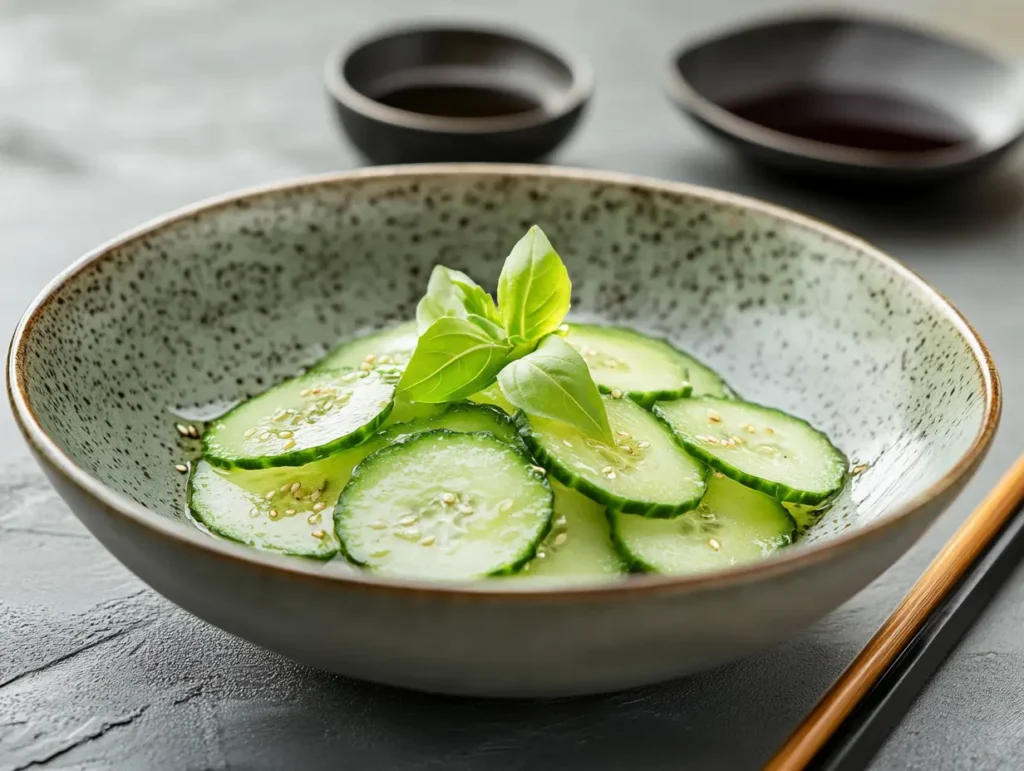
With so many options, Japanese cucumbers provide endless creative opportunities for your kitchen adventures.
Recipe Spotlight: Japanese Cucumber Salad
One of the simplest yet most delectable ways to enjoy Japanese cucumbers is through a classic cucumber salad. Here’s everything you need to make this refreshing dish:
Ingredients Needed
- 2 fresh Japanese cucumbers
- 2 tbsp rice vinegar
- 1 tbsp sugar
- 1 tsp sesame oil
- 1 tbsp soy sauce
- 1 pinch of salt
- Optional: sesame seeds for garnish
Step-by-Step Preparation
Start by washing the Japanese cucumbers thoroughly and patting them dry. Using a sharp knife or mandoline, slice the cucumbers into thin, even rounds. Place them in a mixing bowl and sprinkle them with a pinch of salt to draw out any excess moisture. Let sit for 5-10 minutes, then gently squeeze out the liquid.
In a separate bowl, whisk together the rice vinegar, sugar, soy sauce, and sesame oil to create the dressing. Pour the dressing over the cucumber slices and toss until evenly coated. Allow the salad to marinate in the refrigerator for 15-20 minutes before serving. Garnish with sesame seeds and enjoy chilled.
Serving Suggestions: Pair this salad with grilled fish or rice dishes to create a light, balanced meal. It’s perfect for summer meals or as a quick appetizer for a dinner party. For more salad ideas and inspiration, check out this guide to Japanese Healthy Cucumber salad.
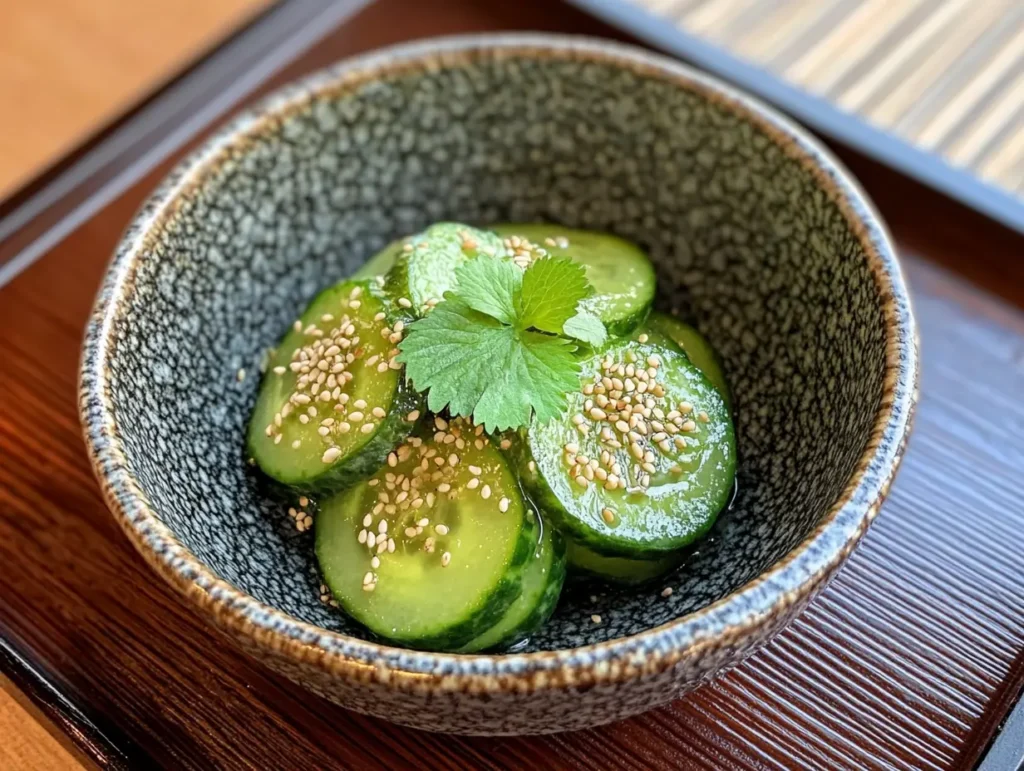
Creative Uses of Japanese Cucumbers in Cooking
Beyond salads, Japanese cucumbers shine in a variety of creative dishes that highlight their crispy texture and subtle sweetness. One standout use is in Cucumber Sushi Rolls. Thin cucumber strips are often used as both a filling and garnish. Combined with fresh fish, avocado, and sushi rice, they add a refreshing crunch to the rolls. For a fun twist, try making cucumber-wrapped sushi, where the cucumber replaces the seaweed entirely.
Another innovation is Cucumber Gazpacho, a modern take on the classic cold soup. Blending Japanese cucumbers with yogurt, herbs, and a hint of lime creates a vibrant, creamy soup perfect for summer. Serve it as a cooling appetizer or a light lunch.
For a simpler approach, Japanese cucumbers can infuse beverages with a refreshing taste. Thin slices added to water, lemonade, or cocktails like gin and tonic deliver a subtle hint of sweetness and elevate any drink. You can also pair them with herbs like mint or basil for a uniquely flavored infusion.
With such versatility, these cucumbers make it easy to get creative in the kitchen. From sushi to gazpacho and beverages, they offer fresh and exciting possibilities your taste buds will love.
Comparing Japanese Cucumbers to Other Cucumber Varieties
When it comes to cucumbers, not all varieties are created equal. Japanese cucumbers stand out for their consistent flavor, texture, and culinary versatility. But how do they compare to other types like English or Persian cucumbers? Let’s take a closer look.
Differences in Taste and Texture
One of the most defining qualities of Japanese cucumbers is their consistently crisp texture and *mild, sweet taste*. English cucumbers, while also mild, tend to have a slightly watery flavor. On the other hand, Persian cucumbers are crunchy but have a slightly earthy undertone. The *slender shape* and thin, delicate skin of Japanese cucumbers eliminate the need for peeling, which is a common step required for some other varieties.
Culinary Applications
Japanese cucumbers excel in recipes where the cucumber’s texture plays a critical role. For example, in sushi rolls or cold salads, their balance of crunchiness and sweetness shines. In comparison, English cucumbers are ideal for slicing into sandwiches and Persian cucumbers often work better in pickling due to their smaller, uniform size. If versatility is your goal, Japanese cucumbers are a clear advantage.
Price and Availability
Japanese cucumbers can sometimes be pricier due to their specialized cultivation methods. However, many local Asian grocery stores now stock them regularly at reasonable rates. English cucumbers, by contrast, are more widely available and generally less expensive. While Persian cucumbers are more affordable than Japanese cucumbers, they are often less available in areas outside of the Mediterranean or Middle East. For those seeking superior quality, the higher cost of Japanese cucumbers is worth the investment.
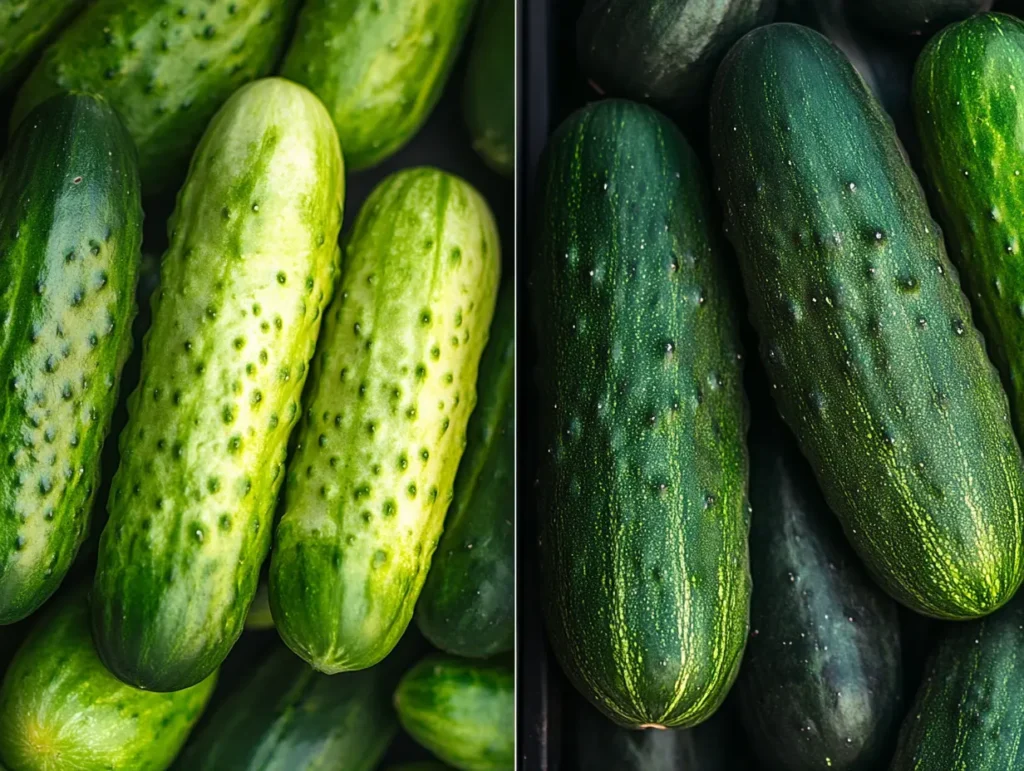
Tips for Preparing Japanese Cucumbers
Maximizing the flavor and texture of Japanese cucumbers doesn’t have to be difficult. With the right preparation techniques, you can bring out their best qualities effortlessly. Here are some tips to make the most of this versatile ingredient.
Cleaning and Slicing Techniques
Always wash Japanese cucumbers thoroughly under cold water to remove any dirt or residue. Since their skin is thin and often consumed, there is no need for peeling, which preserves the nutrients. When slicing, use a sharp knife to ensure clean, even cuts that help maintain their crispness.
Avoiding Bitterness
Although Japanese cucumbers generally lack bitterness, it can sometimes occur in overripe fruits. To address this, slice off the ends and rub them on the exposed surface in a circular motion. This helps release any bitter compounds. Another alternative is marinating the slices in a pinch of salt for 10 minutes before rinsing.
Enhancing Flavor
To elevate the *natural sweetness* of Japanese cucumbers, consider seasoning them with rice vinegar, sesame oil, or a sprinkle of chili flakes. For a more savory approach, you can marinate them in soy sauce and garlic for added depth. These enhancements make them suitable for dishes ranging from salads to side dishes.
Craving more inspiration? Discover what goes into a perfect cucumber dressing for your salads and meals.
Frequently Asked Questions (FAQ)
Japanese cucumbers have intrigued many culinary enthusiasts, and understandably so. Below are some of the most common questions about these unique vegetables, with brief and informative answers.
- Why are Japanese cucumbers so good?Their *mild flavor*, *crisp texture*, and thin, edible skin make them perfect for a variety of dishes, from fresh salads to sushi rolls.
- Are Japanese cucumbers seedless?While not entirely seedless, their seeds are tiny and almost imperceptible, adding to their overall enjoyment without the need for removal.
- Can I substitute Japanese cucumbers for regular cucumbers in recipes?Absolutely! However, regular cucumbers may need peeling, and the texture or flavor might differ slightly.
- What are the health benefits of Japanese cucumbers?They are low in calories, high in water content, and rich in essential nutrients like Vitamin K, Vitamin C, and dietary fiber.
- How do you store Japanese cucumbers to keep them fresh?Wrap them in a damp paper towel and store in a perforated bag within the refrigerator’s vegetable compartment. This keeps them crispy for up to a week.
Conclusion
In summary, Japanese cucumbers truly stand out for their exceptional *flavor, texture,* and versatility. Their thin, crisp skin and minimal seed content make them a delight for both novice cooks and seasoned chefs.
As explored, their unique dimensions go beyond taste—they’re also nutritionally rich and easy to prepare. Whether you use them in sushi, salads, or beverages, their adaptability is unmatched.
So why not give them a try? Incorporate some *Japanese cucumbers* into your next dish and experience firsthand why they are so highly regarded in culinary circles. You just might discover your new favorite ingredient!
Expand your skills: Uncover the role of vinegar in Japanese cucumber recipes and how it enhances their flavor.

